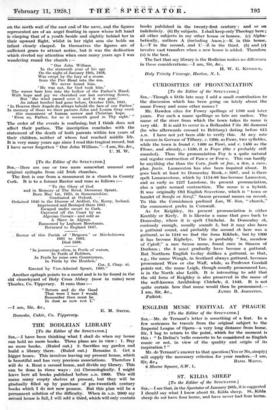[To the Editor of the SPECTATOR.] . Srn,—Epitaphs are always interesting
for the reason that they reveal human character, though more often than not
on the quaint side. May I ask you to insert the following as a sample of touching pathos and tragedy ?
I- should explain the lines are below a bas-relief in white marble mounted on black in the Church of Holy Trinity,
On the north wall of the east end of the nave, and the figures represented are of an angel floating in space whose left hand is clasping that of a youth beside and slightly behind her in their upward flight, whilst in her right arm she holds an infant closely clasped. In themselves the figures are of sufficient grace to attract notice, but it was the dedication which riveted my attention when once many years ago I was wandering round the church
" Our John William In the sixteenth year of his age On the night of January 19th, 1858, Was swept by the fury of a storm from the Pier Head into the sea.
We never found him.
` He was not, for God took him.'
The waves bore him into the hollow of the Father's Hand.
With hope and joy we cherished our last surviving flower, But ` the wind passed over it and it was gone.'
An infant brother had gone before, October 15th, 1841. In Heaven their Angels do always behold the face of our Father.'
In memory of these we their parents John and Louisa Gray erect this monument of human sorrow and Christian hope. - ` Even so, Father, for so it seemeth good in Thy sight.' "
The order of the events is confusing, but I think does not affect theit pathos. The inscription concludes with the statement of the death of both parents within ten years of their children, neither of whom had reached middle life. It is very many years ago since I read this tragical record, but I have never forgotten " Our John William."—I am, Sir, &c., U. M. W.







































 Previous page
Previous page